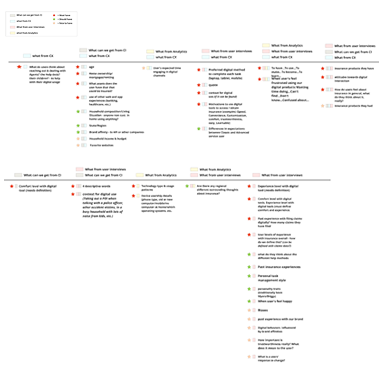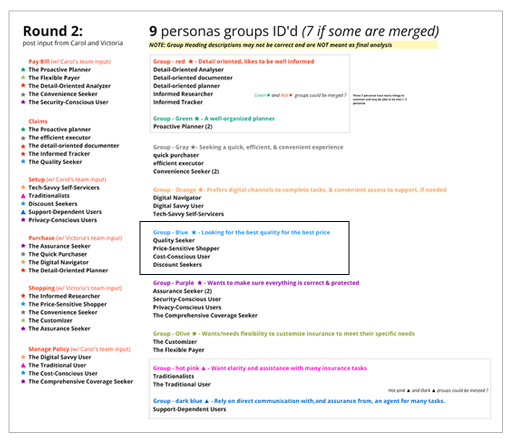American Family Insurance
UX Personas
Summary
To create UX personas for the DEUK (Digital Enterprise User Experience team to replace the marketing personas they had been using.
* Some images are intentionally blurred to comply with legal and confidentiality requirements related to my work with an insurance company.
The Goal
Create research-based UX personas that guide UX designers, researchers, and content specialists toward more informed experience decisions for current and future customers.

Timeline
8
months
Collaboration
CX
CI
Data Analyst
UX Designers (20)
UX Researchers (3)
UX Strategist (1)
UX Content (4)
UX Managers (2)
Tools
Figma
Miro
Teams
Focus Groups
Jira
Confluence
My Role
Project Lead
UX Strategy Lead
UX Designer

The First Workshop
I facilitated a workshop with the UX, CX, and CI Teams to uncover current views, needs, and expectations regarding UX personas. It helped me get a feel for what the team might want and expect from the UX personas.
During this workshop, I discovered that some team members did not know the difference between a marketing persona and a UX persona. We addressed this with a presentation to all collaborators.

What are UX Personas?
Detailed representations of user types, based on behaviors, needs, and motivations.
- Marketing personas support how you sell.
- UX personas shape what you design and build.
Teaching Stakeholders The Difference Between Marketing And UX Personas
Marketing personas focus on demographic and psychographic details to
guide marketing strategies.
- Determining if a sales concept will achieve desired results with a target audience.
- Iterating and adjusting a company-wide strategy or concept to optimize its effectiveness.

Sample marketing persona

Phase 1 - Assessing Current State
Reviewing Existing Personas
I began by reviewing existing personas. All personas created in the past had been marketing-focused. While somewhat helpful, they lacked depth around user pain points and a strong digital perspective—both critical for satisfying digital UX. .
Images are blurred to meet legal and confidentiality requirements.

Phase 2 - Gathering Data

From the CI (Customer Insights) Team
Data Gathered
- Life stages
- Experience levels
- Confidence levels
- Risk tolerance
- Expectations set by other products or industries
- Call center and support feedback summaries
Yields
- Goals
- Motivations
- Attitudes
- Real quotes
- Real scenarios

From the CX (Customer Experience) Team
Data Gathered
- Customer journey maps
- User wants and needs
- Struggles and pain points
- Reasons for most popular service interactions
- When users want to seek help
- Interaction preference types
- Where users want help
- Reasons for staying/leaving flows and services
Yields
- Frustrations
- Emotions and mindsets during tasks
- Preferred usage channels
- Help and support expectations
- Reassurance needs
- Trust needs

The manage policy journey is organized into flow-oriented stages, with color highlights indicating user actions, requirements, pain points, and digital feedback channels.

From the Analytics Team
Data Gathered
- Task frequency and duration
- Feature usage patterns
- Success and failure rates
- Emerging behaviors
- Primary and secondary behaviors
- Usage intensity
Yields
- Primary vs. secondary behaviors
- Usage intensity and habits
- Evidence-based priorities
- Validation that the personas represents real user groups


JD Power Studies

Research team feedback from user tests.
independent customer satisfaction surveys and User Tests
Information from research teams' user tests and J.D. Power Insurance Digital Experience studies and reports were also used to gather data.
These revealed areas of the experience where opinions about the UX had risen or fallen in rank in the past year.
User tests by research returned several real user quotes.

Phase 3 - Synthesizing Data
CX, CI, And Data Analytics
I Collaborated with CX (Customer Experience) and CI (Customer Intelligence), and Data Analytics teams to gather existing research for the UX personas.
After viewing the materials, I:
- Identified which UX-specific content needs aren’t covered by current CX or marketing personas
- Grouped the content by research source and ranked it by priority—essential, important, and nice to have
- Narrowed it to six key content areas and their supporting sources, which became the core building blocks for our UX personas
Case Study
AI-PaIred Support
The Company’s internal AI chatbot, was built to assist employees by answering questions about company policies, and operations. It draws from a curated set of internal tools and data sources.
I relied on the AI chatbot early in the archetype creation process to efficiently analyze and organize complex journey data.
It played a role in the early stages of this project by helping process large volumes of internal data. I leveraged its strengths (accurate internal data, pattern detection in large datasets, data summarizing) while being mindful of its limitations (all output needed refinement, limited data sources).
a
With research complete, I moved into analysis—looking for patterns to inform meaningful user personas.
I began by reviewing six key user journeys: Shopping, Purchase, Bill Pay, Manage Policy, Setup, and Claims.
Each was broken into distinct stages, and for each stage, I tracked four key factors:
user goals, needs, pain points, and their digital capabilities (e.g., Retention app, Dotcom web/app, live chat, chatbot)
I also reviewed the following data sources
- NPS scores, journey maps, personas, segmentation
- Segmentation strategy and data insights
- UX Analytics data from platform usage metrics
- JD PoIr (June 2024): Pain points, industry insights, service/shopping evaluations, and the top 3 digital KPIs
I used the company’s AI tool to identify 16 user segments across six key journey stages and surfaced 28 initial archetype categories, which I grouped by shared traits. By aligning common characteristics across journeys, I refined and consolidated these into nine distinct, behavior-based proto-personas. I then created sample personas for each of the 16 segments, mapping them to the proto-personas to ensure consistency and relevance.
At the end of Phase 3, five final personas were distilled from the nine proto-personas, with additional alignment from sources like the J.D. Power U.S. Insurance Digital Experience Study.
Phase 4 - Feedback And Refinement
Second Workshop
In the workshop, the UX team reviewed archetype bios, voted on photos, and finalized biographies, imagery, and designs.
In the third workshop, we explored how personas could support more personalized digital experiences.
Key Uses of Personas:
Prioritizing features
Justifying design decisions
Shaping visual hierarchy
Centering user needs over stakeholder opinions
Accelerating stakeholder alignment
Identifying secondary persona pain points
Writing user stories
Building tailored messaging, voice, and tone strategies
This is paragraph text. Click it or hit the Manage Text button to change the font, color, size, format, and more. To set up site-wide paragraph and title styles, go to Site Theme.
Phase 5 - Socialize And Iterate

Conclusion
I distilled insights into five relevant, actionable personas through a collaborative, multi-phase process that combined research, AI analysis, and team feedback.
The personas emphasize user behaviors, goals, and pain points across many digital journeys rather than demographics, and provide the UX team with clear guidance to prioritize features, justify design choices, and create more personalized, user-centered experiences.















